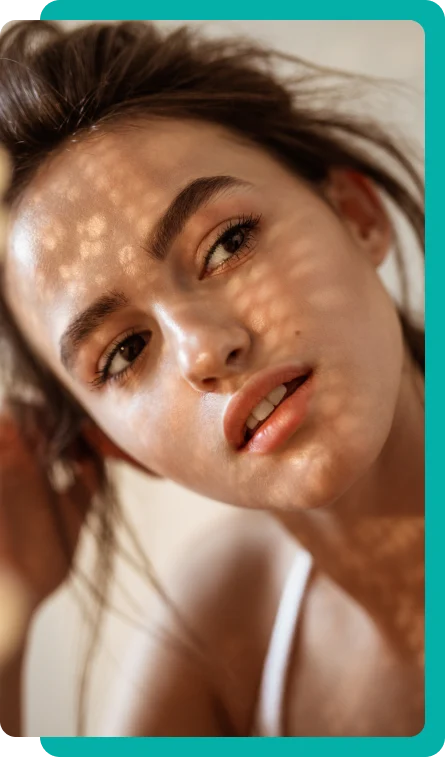For Patients
About
For Providers
Locations
Blog
Contact
Menu
As we age, regions in our faces naturally start to lose structural support, causing many changes around facial contours such as the sagging and sinking of the cheeks. Cheek fillers, also known as cheek augmentation, are a popular medical procedure for cosmetic concerns. This type of injection creates a “plumping” effect that boosts cheek volume, restores your natural cheekbone structure, and provides a lift to your mid and lower face.
So how long does cheek filler take to settle in the skin? It takes 14 days at most for cheek filler injections to settle. Even better, a dermal filler procedure is low-risk and has no downtime.
Many cosmetic procedures, especially invasive ones like plastic surgery and laser treatment, can take a long time – sometimes even an entire year – to show significant results. Fortunately, a dermal procedure, including cheek filler, doesn't take that long. While these injectables need some time to integrate into the body’s tissues, you can see the visual benefits in, at most, 2 weeks.
Most of the time, a dermal filler procedure uses hyaluronic acid filler to create moderate enhancements in your cheeks. Expect that your facial features may look plump for a few days. But as your skin adjusts to the filler, your cheeks may become slightly smaller and you’ll see the final outcome in no time.
Dermal fillers take no more than one hour to administer. The cosmetic surgeon will discuss with you your aesthetic goals and choose the most suitable cheek filler. Once they place temporary markings on your face, a numbing agent will be applied to minimize pain.
They will then strategically inject the cheek filler into your face, reaching all the required areas beneath the skin, and apply a bit of pressure. After both sides of the cheeks are filled and massaged, you will see instant results such as contour and raised cheekbones. No downtime is required.
You won’t have any major disruptions to your personal, work, and social life while waiting for your cheek filler to settle; however, you will need to comply with some aftercare advice. Following the injection of the cheek filler, we recommend not consuming alcoholic beverages and avoiding strenuous activities like lifting heavy items) to prevent bruising and swelling. Don’t apply harsh pressure and makeup on the injected area for at least 24 hours to help the filler settle into the skin.
Giving your skin some extra care is a good way to extend the longevity and benefits of your dermal filler treatment. Follow a regular skincare routine with anti-aging products. Don’t forget to put on sunscreen as ultraviolet rays (UV) can cause your skin to develop premature lines, wrinkles, and age spots.
When a dermal filler injection is administered by an experienced doctor, it can effectively lift the cheek and under the eye area. It’s a non-invasive and fairly straightforward procedure with minimal recovery time. Take note that dermal filler is usually composed of hyaluronic acid, a naturally occurring substance in the skin. But as with any cosmetic procedure, there are risks involved.
The general, but minor, side effects of cheek filler treatments are itching, redness, bruising, swelling, and bleeding. In terms of aesthetics, for a short amount of time, you may notice lumps and asymmetries until the cheek filler fully settles in your face. There is no reason to worry as for worst-case scenarios, a cosmetic practitioner can add more filler, wait for the substance to metabolize on its own, or use a filler dissolver.
Very rarely, serious medical complications that may occur include filler leakage, infections, skin damage, allergic reaction, and vascular occlusion (when the aesthetic provider accidentally injects the filler into a facial artery). Given, dermal filler results show right there and then, the occlusion risk window would be closed as soon as you leave the doctor’s office. Just make sure that you are the ideal candidate for the procedure.

The results of cheek filler injections look natural because they are. Most cheek filler formulations' active ingredient is hyaluronic acid or collagen. When injected into the foundational layers of the face, it encourages the body to produce these same enzymes and thus perpetuate the following benefits:
Since aging skin tends to lose volume, the skin on your cheeks may start to sag and feel hollow. Dermal fillers can add natural-looking volume to the midface area. Keep in mind that results improve over time. As the filler is processed by your body, the final results of your cosmetic procedure will be seen after a few weeks. And should you want to reverse your treatment, a doctor can administer a painless injection of hyaluronidase.
For patients who are concerned with volume loss and fine lines, cheek filler can transform facial structure by reflating the areas of concern. This way, nasolabial folds are less visible and the cheeks are lifted.
Dark undereye shadows are related to sagging cheeks, which can be resolved by clever cheek filler placement usually in the lid-cheek junction area. Cheek filler treatment can enhance the appearance of the patient’s cheekbones and thus improve facial contours.
You would need to be cognizant of your aesthetic goals. If you find yourself adding slight pressure to your eyebags or pulling your cheeks up, you’re in facelift territory, not a dermal filler.
As mentioned, cheek filler treatment can replace the missing volume of aging skin, making you look years younger. It also helps the face appear more symmetrical. You no longer need to use contour to accentuate certain areas nor add some highlighter to make your skin look more shiny and radiant.
That said, an experienced practitioner should be familiar with how dermal filler can mimic the way natural light strikes the patient’s cheek, especially in the higher cheekbone area. They should base their injection patterns on how makeup is applied to the cheeks to give an enhanced and more defined appearance, without creating excessive volume.
A high-density cheek filler can be a relatively low-risk method of achieving a more youthful, rejuvenated look by restoring the lost volume in concave temples. Despite temples being a completely different region in the face, there are crossovers in every facial zone. You would need an experienced dermatologist with a deep understanding of facial anatomy as the temples are one of the most anatomically difficult injection areas.
Filler brands differ in formulation, longevity, and dosage requirements, and have varying degrees of softness. More often than not, sturdier types of filler are used to enhance patients’ cheekbones.
No matter which filler you opt for, consulting with your doctor, asking all your questions, and making sure that you’re comfortable are key to achieving the best results for the longest period of time. The filler injection process is highly personalized, so it’s best that you and your doctor are on the same page.
This brand’s main ingredient is called polymethyl-methacrylate microspheres (PMMA). It is a semi-permanent filler that is usually recommended for medium to deep wrinkles and nasolabial folds. It may take a number of dermal filler injections before you see its full effects.
Radiesse’ active ingredient is calcium hydroxylapatite, a similar component naturally found in the body’s bones and teeth. It differs from other cheek filler formulations as it stimulates the production of natural collagen – meaning its effects last longer and it lowers the risk of allergic reaction. It enhances the fullness of cheeks and other facial contours, without the need for touch-ups.
Restylane, one of the most commonly used dermal fillers, is a hyaluronic-based injectable that is best used around the mouth and eye area. It can reduce cheek depression, soften the appearance of wrinkles and hollowness, as well as correct volume loss. Its variant called Restylane Lyft is specially designed for the cheek and midface area.
Juvederm Voluma and Juvederm Ultra use high concentrations of hyaluronic acid to smoothen moderate to severe facial lines and to hydrate patients’ skin. Effects last longer than some fillers.
Sculptra works a bit differently compared to other facial filler brands as it relies on polylactic acid, a synthetic ingredient that stimulates collagen but doesn’t produce instant results. This specific substance is known to work particularly well in the lower half of the face. If you’re looking for a cheek augmentation solution, you will most likely need a number of vials over the course of three months.
One of the reasons why dermal fillers, especially hyaluronic acid fillers, are so popular is that nearly everyone can be considered a good candidate. If you aren’t currently pregnant or breastfeeding, don’t have a smoking habit, and do not have a history of chronic health conditions or bleeding disorders, you may be a candidate for cheek filler injections.
However, even if you are an ideal candidate, it is crucial that you take care of your skin and schedule your appointments. You need to consult your doctor whenever you experience side effects such as skin infections, a fever, and cold sores, among others.

Dermal fillers are a low-risk cosmetic procedure that can enhance your facial contours and give you a youthful look. Cheek filler injections, in particular, settle fairly quickly, with a waiting time of 14 days at most to see the final results. If you want to achieve your aesthetic goals, make sure to find a cosmetic provider who has years of experience in performing dermal filler procedures.
At Dr. Lanna Aesthetics, we are passionate about helping our clients feel confident in their own skin. With our team of doctors, we’ll help you reverse the signs of premature aging, develop a personalized treatment plan, and teach you how to maximize the longevity of your cheek fillers. Schedule a consultation today.

Join Dr. Lanna & Dr. Doshi for a Transformation
Unlock the possibilities with our certified facial and oculofacial plastic surgeries. Attend our free webinar to find out how we can tailor solutions for you, with financing available to fit your budget.
